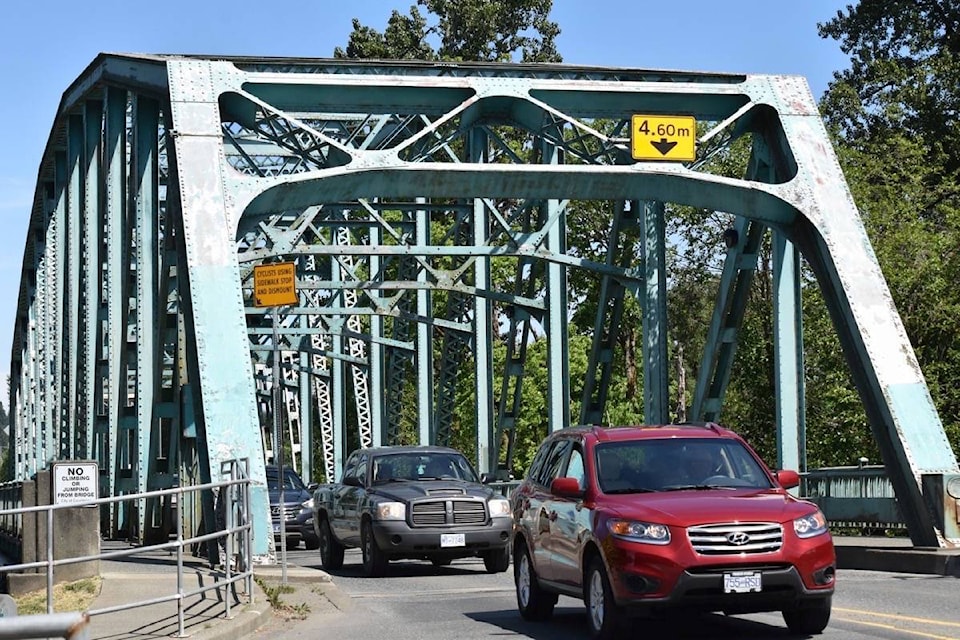An attempt by Courtenay council to rescind an earlier vote to include cantilevers in 5th Street Bridge repairs narrowly failed at Monday’s meeting.
At committee of the whole June 24, council voted 5-2 in favour of cantilevers, which will widen both sides of the bridge to accommodate pedestrians and cyclists. Manno Theos and Doug Hillian were the naysayers. At the Sept. 16 meeting, Hillian asked council to reconsider the June 24 vote to allow discussion to honour feedback from the community. The Downtown Courtenay Business Improvement Association does not believe widened walkways will enhance safety. Some merchants worry about going out of business during the repair period.
READ: Downtown Courtenay business group…
READ: Business owner blasts council….
“I think it’s only fair that we have this debate again,” said Hillian, a longtime proponent of constructing a pedestrian bridge at 6th Street. He voted against the multi-use pathway (cantilever) option due to timing and community support, or lack thereof. “What I think we have now is an opportunity to get the Sixth Street Bridge built. This is a concept that has the potential to be a real positive factor for our community. Instead of going ahead with a multi-use pathway, and having a divided community, we have an opportunity to change course and have most of our community in support of moving forward with the Sixth Street option…That doesn’t mean that we never build cantilevers, it just means we don’t do it now.”
He notes the cantilever option has not been fully explored.
Cantilevers will add $2 million to an estimated $6.3 million to recoat and renew the bridge deck. They will also increase the construction period from six to eight months. Theos said construction could exceed that time, and jeopardize a government grant for the project.
“We know that downtown businesses are going to be affected dramatically as a result of the bridge closure,” Theos said. “The extra two months could be the make-or-break point for many of those businesses. We know there’s potentially an option at 6th Street (to build a pedestrian bridge), and we could receive grants…We’re up against significant budget restraints.”
He said major projects could leave the city with huge increases in the next five years.
“The way of mitigating it is not to have cantilevers and a second bridge, that’s why I believe it’s one or the other,” Theos said.
He suggests switching focus to the 6th Street option early in the process to secure grants, and to relieve stress felt by the travelling public and businesses.
Mayor Bob Wells motioned to rescind the June 24 vote. David Frisch seconded the motion.
Wells noted that, over the last year, bridge costs have doubled without cantilevers. He recalls opposition to a bridge at Sixth Street, which now has support from people he has spoken with. He is confident the city has strong support from senior governments, in terms of grant funding, to build a crossing at 6th in a timely fashion.
“Cantilevers might happen in the future, but might require doing far more than we think and be part of a bigger plan,” Wells said.
But the motion to rescind failed 4-3. The no votes came from Melanie McCollum, Wendy Morin, Will Cole-Hamilton and Frisch — who thinks council is on the “wise path” in terms of the environment, climate change, and long-term benefits to downtown businesses and to transportation planning.
“If we don’t do it now, it’s going to be very challenging to do it later, and at a much higher cost,” said Frisch, who is not confident senior governments will help with $100 million forecasted for road improvements to deal with car traffic. “If we don’t get people on board with the idea of moving away from their car a little more, that $100 million might be more than that.”
McCollum notes the 5th Street Bridge was built in 1957 when the east side of the river did not contain a recreation centre and other structures.
“We have so much more demand on those sidewalks now,” she said. “We’re hoping we’re not going to need any more repair work for 25 years. What is the usage going to look like 25 years from now? Most likely we’ll be quite happy with those multi-modal pathways…I don’t believe that abandoning cantilevers and going with the Sixth Street bridge is somehow going to garner broad community support.”
Cole-Hamilton and Morin would like further information to clarify details about connectivity. Cole-Hamilton’s motion to expedite the range of options for a 6th Street pedestrian bridge received unanimous support.
Building a 6th Street crossing is estimated to cost $2-$4 million.
Cantilever construction is expected to begin in 2020 or 2021. The bridge would remain open to single-lane traffic during construction, though it might need to be fully closed for short periods. Council will eventually consider a draft borrowing bylaw. The project will receive a $1.96 million federal grant if completed by March 2022. The remaining $6.3 million is proposed to be funded by the City, and possibly include reserves and borrowing. Loan authorization could be through the Alternate Approval Process (AAP) or a referendum. The AAP involves at least 10 per cent of electors petitioning against the proposed borrowing bylaw. If this were to occur, a referendum would be required to place the borrowing request before electors.
Project updates are available at www.courtenay.ca/fifthstreetbridge.



